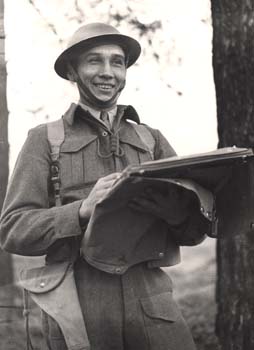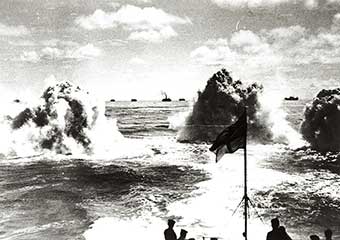Canada Remembers Times - 2013 Edition - Page 3
A Trailblazer in the Skies

Gerry Bell during the Second World War.
(Photo: Canadian Warplane Heritage Museum 000595)
Gerry Bell was born in Hamilton, Ontario, in 1909. A gifted athlete, he excelled at competitive sprinting and boxing as a young man. He had been studying medicine when he developed an interest in aviation and decided to obtain his private pilot’s licence. He enlisted with the Royal Canadian Air Force during the 1930s, likely the first Black Canadian to do so. When the Second World War erupted in 1939, he quickly volunteered for active service. He initially served at a number of bases across Canada, performing duties like being an aircraft engine mechanic, and rose to the rank of sergeant. In March 1943, he was posted overseas and remained in England until June 1945.
Bell continued to serve in uniform after the war in a variety of postings in both Canada and Germany. He retired from his lengthy military career as a warrant officer in 1961. He continued to work in the aviation industry, however, and played a role in the restoration of a Lancaster bomber—now one of only two still flying today—for the Canadian Warplane Heritage Museum, located in Mount Hope, Ontario.
Lifelong Accomplishments

Lieutenant David Greyeyes in September 1943.
(Photo: Department of National Defence)
Aboriginal Canadians have a long and proud tradition of military service for our country. One of the finest examples was David Greyeyes from the Muskeg Lake Cree Band in Saskatchewan. He enlisted in the Canadian Army in June 1940 during the Second World War. Two of his brothers and a sister also served.
Greyeyes was an instructor in Britain before becoming an officer and commanding a platoon with the Saskatoon Light Infantry (Machine Gun) Regiment. He took part in the invasion of Sicily and the fighting in mainland Italy, earning a medal for his actions in the capture of Rimini. He later saw action in Northwest Europe. He returned home after the war to farm and married Flora Jeanne, an Aboriginal Veteran of the Royal Canadian Air Force - Women’s Division.
Greyeyes would go on to hold important positions with the Department of Indian Affairs and he served as a chief of his home band. He was also voted into the Saskatchewan Sports Hall of Fame and named a Member of the Order of Canada before passing away in 1996.
From Leather Town to the Front Lines

Canadian soldiers checking their army boots in 1945.
(Photo: Library and Archives Canada PA-114602)
In 1933, Georges-Alidor Boulet established G.A. Boulet Incorporated in Saint-Tite, Quebec. This small community was often referred to as “the Leather Town” for its production of high quality leather products. In fact, Boulet was commissioned by the Canadian Army to produce all its military footwear during the Second World War!
Today, Boulet is the largest maker of cowboy boots in Canada with distribution in more than fifteen countries. Whether for soldiers or cowboys, those boots are made for walking!
A Cruel Ocean Battleground

Depth charges being dropped by HMCS Saguenay during the Second World War.
(Photo: Library and Archives Canada PA-116840)
The Battle of the Atlantic was the longest campaign of the Second World War, lasting almost six years, from September 1939 to May 1945. It was a showdown between the Allies, who were transporting desperately needed troops and supplies from North America to Europe, and the Germans, who wanted to cut that supply line. The enemy’s U-boats (submarines) caused great losses and brought the front lines to our doorstep, when the Germans sank Allied ships off Canada’s East Coast and even as far inland as the St. Lawrence River.
It was a great struggle. With courage and the adoption of new technology and tactics, however, the tide turned and the Allies would eventually triumph in the war at sea. More than 25,000 merchant ships safely made it to their destination under Canadian escort, delivering approximately 165 million tons of supplies to Europe. The Royal Canadian Navy helped sink more than 30 enemy submarines, but at a steep price. They lost approximately 2,000 sailors during the war. The Royal Canadian Air Force was also hit hard, losing more than 750 personnel over the Atlantic. More than 1,600 merchant mariners from Canada and Newfoundland were killed during the battle. Civilians were not spared either. On October 14, 1942, 136 people died when the ferry SS Caribou was torpedoed as it crossed from Nova Scotia to Newfoundland.
Canadians and the Italian Campaign

Canadian soldiers in Italy in December 1943.
(Photo: Library and Archives Canada PA-136332)
More than 93,000 Canadian men and women served in the Italian Campaign during the Second World War. They took part in Operation Husky, the Allied invasion of Sicily on July 10, 1943, and helped take the strategically important Mediterranean island. The offensive resulted in Italy overthrowing dictator Benito Mussolini and formally surrendering. Germany, however, refused to see the country fall to the Allies. It moved its soldiers in to fight and the campaign continued. Next up were landings in mainland Italy on September 3, 1943, and the Canadians would join the long, tough advance up the peninsula. The many mountains, deep valleys and rivers gave the determined German defenders a great advantage. Despite it all, the Canadians helped push the enemy back in a series of battles through places like Ortona, the Liri Valley and Rimini.
As it turned out, our soldiers would not be part of the final Allied victory in Italy. They were transferred in February 1945 to join the First Canadian Army fighting in Northwest Europe. More than 26,000 Canadians became casualties during the Italian Campaign, including nearly 6,000 who gave their lives.
From Privilege to Prison

Mona Parsons before the war.
(Photo: Public Domain)
Mona Parsons was born in Nova Scotia in 1901. She married a Dutch millionaire businessman in 1937 and they soon moved to the Netherlands.
After the Germans invaded in 1940, the couple joined a resistance unit and began hiding downed Allied airmen in their mansion until they could be smuggled back to safety in England. Unfortunately, they were betrayed and arrested by the Gestapo in 1941. Parsons was found guilty of treason and sentenced to death by firing squad. Her dignified calm, however, convinced the judge to change her sentence to life in prison.
Following the bombing of the prison where she was held captive in Germany in 1945, Parsons and a friend escaped. Disguised as local sisters, the pair evaded capture for three weeks. After walking some 125 kilometres back to the Netherlands, Parsons finally reached the safety of the Allied lines. Remarkably, the first soldiers she met were from the North Nova Scotia Highlanders.
Parsons was honoured for her bravery in helping downed Allied airmen and received commendations from the British Air Marshal and American General Dwight D. Eisenhower.
- Date modified: